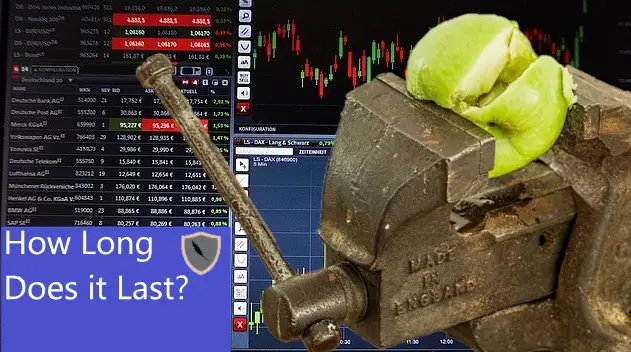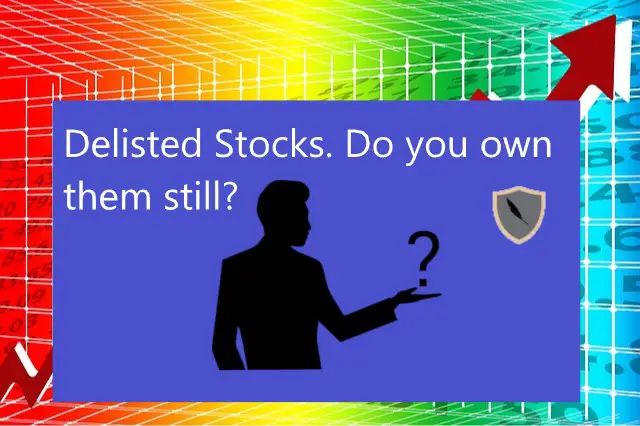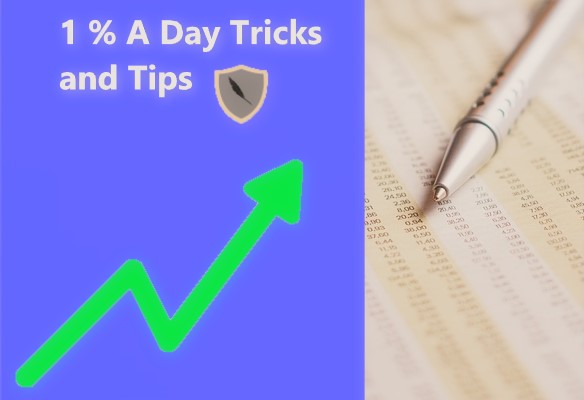Learning how to invest $1,000 properly in the market can net you huge returns. Unfortunately for many of us the dollar sign for these investments is just too large to see any sizable return.
The top 5 best ways to invest $1,000 in the stock market for growth are ‘double-dipping’ on index ETFs, investing in mid-cap growth stocks, buying and selling option contracts, and algorithm trading.
I am not here to give you another article that will have you gain 3-6% return over the next six months. Here we are going to look at how to take that $1,000 and make huge returns in the range of 17-25%. Be warned however, as increasing potential growth increases risk.
This is because if we are chasing high returns well above the normal market return of 8-10% we are going to be taking on above an average amount of risk in our portfolio. If one of these investments fits within your portfolio then feel free to add it in but remember the increased risk profile that it generates.
Increased reward means increased risk
As the above image shows, as we increase our target goal percentage gain on an investment so will our risk increase. Unfortunately this risk increase is unavoidable but depending upon the investment and your risk tolerance you might not care. As a 1966 Irish proverb states “Risk it for the Biscuit.” (Source)
As always if you like content like this then you should share on social media and subscribe to the newsletter.
Without further ado, let’s jump into the top 5 best ways to invest $1,000 in the stock market for growth.
‘double-dipping’ Investing in Index ETFs and selling Puts on Downswings
20 year chart on SPY
This is a personal favorite of mine to generate extra capital over time. You need to have a margin account for this strategy.
This strategy is broken down into two steps; First, you are going to invest in major ETFs such as the SPY with your liquid capital and wait for a strong pullback in the range of 2-5%.
Second, the next step is to sell a put on the SPY that is far OTM and far to expiration. By selling a put you are stating that if the SPY goes down to a certain strike price you will buy 100 shares of SPY.
Since the SPY tracks the U.S market generally it grows by 8-10% per year with temporary corrections to the downside. If this strategy is done properly then you are going to double your potential gains from 8-10% to the range of 17-25%.
Over time as the SPY grows in value that put you sold has a lower chance of going in the money (ITM). As a result you will gain more and more money over time not only when the SPY increases in value but also as the contract ages closer to expiration.
This is called theta decay. When you sell an option contract you collect a premium every day until the contract expires worthless. By selling options on the SPY you are passively collecting premium on an asset that for the past 20 years has consistently grown at a steady pace of 8-10% per year.
The trick to performing this strategy is first you need to have a margin account and second you absolutely need to wait for a market pullback.
20 year chart on the SPY with pullbacks.
The red arrows on the above chart would have been a great time to sell puts. I sold my recent one on the latest red arrow, July 2021.
For a detailed breakdown of this strategy check out the following.
Selling Puts on the SPY: How to Make Massive Returns
Mid-Cap Growth Stocks
The secret weapon for professional investors is investing in mid-cap growth stocks.
This is because mid-cap companies have the ability to rapidly deploy capital and grow in response to market pressures.
For example a large-cap stock like AAPL or MSFT would need to hire a whole new team of product engineers to develop a new product to fit into a new sector. Next they would need to hire the HR personal and management to direct this new team. Finally the large-cap would need to hire a marketing team to sell this product.
This takes way too long and requires huge amounts of capital. Think of a large-cap as a cruise ship, it takes forever to turn and move. The large-cap cruise ship can only go in one direction. They are predictable and stable, as such they make good investments. If you’re looking to grow capital however, it’s a death trap.
A mid-cap company on the other hand would simply have their current talent start developing a new product. This is because the mid-caps overhead (cost to keep the lights on) is significantly smaller. The mid-cap does not need to hire the management, HR, and marketing teams. They just pivot their business model.
Mid-caps have the added benefits of having a stable revenue source in the form of their current products/services. Since their overhead is so small the mid-cap can experiment with other products and sectors easier then a large-cap.
Further, this stable revenue source of the mid-cap means there is less risk than investing in small-caps who generate almost no revenue. Mid-cap stocks are the ‘golden-zone’ that growth minded investors should focus on.
How to find Mid-Cap Companies
The criteria for a stock to be a mid-cap company is pretty self explanatory.
The potential stock generally will have a market-cap between $2 billion to $10 billion.
You can set up a scanner to go through these stocks. The next step is to see what mid-caps are innovating upon their products, sector, or business model.
In order to do this you should look into their financial reports. If they are a U.S based company then you can go to SEC.gov and enter in their ticker to find their reports.
The best place to start to get a general consensus of what the mid-cap company actually does is to look at their 10-k file. The 10-k is the annual report that every publicly traded U.S company must put out. This 10-k document outlines what exactly their corporate model is, their finances, their growth strategy, and their products.
GME 10-k (source)
The above image is of GME’s 10-k. It’s a good start to looking through financial documents and I highly recommend you give it a quick glance when you have the time.
If you practice reading financial documents it will become easier to read through them. Eventually you will become so good at looking through a financial report you can immediately tell if a company is a good investment.
I recommend spending at least an hour a day for a month practicing reading a report. Learn what to look for.
If you want more information on mid-cap companies you can check out the following article that goes into more detail.
Why Mid-Cap Companies are the Best for Growth Investing
Buying and Selling Option Contracts
Ok, now we are entering into risky investments.
Option contracts inherently are depreciating assets. This means that they will lose value over time.
That being said, if you position an option contract correctly then you can make a huge return in a very small amount of time. Trading options is an artform that no one really is a professional at.
It takes a lot of time and research to nail down options, but for many people it’s how they make their living. One good option contract play can return 50-100% overnight!
That being said, more people end up losing money in options contracts when they are buying them. Selling option contracts on the other hand typically results in people making above normal market returns but at considerable risk.
For example here is an image of the options chain on Tesla Inc.
Option chain on 08/19/2021
As we can see if you were to sell a put on TSLA at the strike price of $650 you would instantly make $7,550! This contract expires in 155 days so that means that you would make close to about $48 a day for the lifetime of the contract.
Right now that strike price has close to a 51% of being ITM by the contract expiration. This means that on those sold out you have a 51% chance of having to buy 100 shares of TSLA at the price of $650. If the share price never touches $650 then you keep the full $7,000 amount.
Likewise if you bought a put on the $650 strike price then you would have around a 49% chance of making money. This is because you would be selling 100 shares of TSLA (you don’t have to own them) to the person who sold the put at a price of $650 a share regardless of current share price.
If TSLA was went down to $500 then you would make $150 a share times 100, or around $15,000.
Engaging in Algorithm Trading (quant)
Ok, so this is going to sound like magic to some people. You can make close to about 1% per day by having a computer execute trades on your behalf.
The best way to go about this is to write a computer program in Python that engages in arbitrage trading. Arbitrage trading simply explained is just exploiting small numerical differences between two correlating values.
The best thing about arbitrage trading is that when correctly executed an arbitrage trade is completely independent of outside variables such as politics, inflation, etc. This is one the main reasons why quant firms have exploded over the past decade. It’s a fast growing field and if anyone wants a good job there are several quant funds that hire junior level python developers.
The skills that are needed to become a good quant are Python, Tableau (data visualization software), GIS, or another emerging field dealing with data science. Knowing SQL or being a master of Excel is a plus as well but not mandatory for a lot of funds.
Example of Quant Trading
For example, each stock has a bid and ask spread associated with them. You can write a python algorithm that will place a limit order on the buy. Once the order is filled the algorithm will instantaneously place a limit order on the ask to sell your shares.
If done properly then you will make the difference between the bid and the ask. This is called playing the spread and there are several quant firms out there that execute thousands of trades per second.
Black Squiggle is the algorithm trade
The above image demonstrates the theory behind this investing methodology.
The ask price of a stock, or what sellers are asking their shares be sold for, will always be higher then the current value of the stock. The bid price of the stock, or what the bidders are willing to pay for shares, will always be lower than the current price of the stock.
Since you are using a computer to trade you will execute order placements faster than a human can type. Because of this you will always get the better price on both ends of the trade, the buy, and the sell.
This better price is what you exploit over time. With each successful trade you sell into retail investor support and scalp a couple of pennies. This over time adds up and it’s not uncommon to see some quant firms returning 1-2% on a good day. This is huge and as a result a lot of quant funds have exploded in AUM (assets under management) over the past decade.
For more info on how to ‘play the spread’ and profit check out this article.
What is the Spread on a Stock: Simple explanation with pictures
Conclusion
Learning to invest properly is a slippery slope. If not done properly you will lose a huge amount of your capital. Normally people don’t bother to learn and instead just invest passively into index fund ETFs. This is a fine strategy if you’re just trying to passively grow a portfolio over 50 years.
However if you are trying to ‘race to the finish line’ of portfolio growth then you will need to take on large amounts of risk within your portfolio. A general rule of thumb is that each 1% gain over normal market return results in 1.1-1.2% gain in total risk in the portfolio.
As a result I would not go above a 25% total gain goal per year as the risk will just be to high. Option contracts are a prime example of this, you could gain close to 100% but end up risking 100% of your total investment. That being said, it’s a great way to strategically boost your yearly gains if done properly.
Also I highly recommend you pick up a python coding course on Financial Technologies to learn how to program an algorithm trading bot. It’s not easy but it opens up a whole new world of investing possibilities for you.
As always if you like content like this then you should share on social media and subscribe to the newsletter! Every share helps me help others so it’s very appreciated.
Further, you can check out some of our other posts below.
-
How Long Does a Short Squeeze Last? (3 Answers)

What is the time frame for you short squeeze? Well here is everything you will ever need to know to determine how long it will last.
-
Why You Still Own a Stock After It’s Delisted and How to Sell It

Do you still own a stock after its delisted? How do you sell it? Don’t worry the stock is still worth money and here is how to sell.
-
Can You Make 1% A Day in the Stock Market? (3 Steps)

Making 1% a day in the stock market is hard but defiantly doable. Here are 3 simple steps to helping you achieve this return.
Until next time, I wish you the best of luck in your investing journey!
Sincerely,



